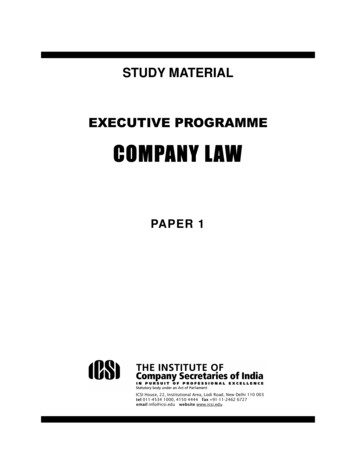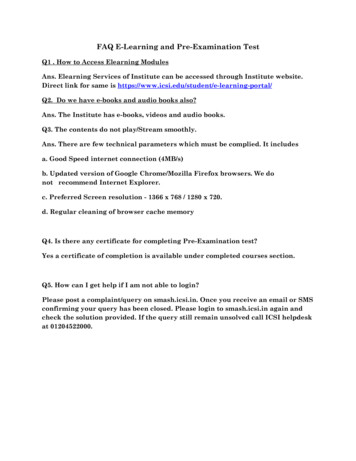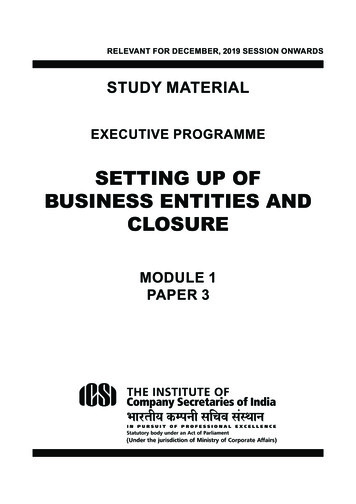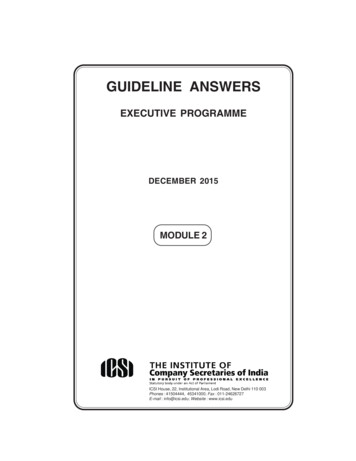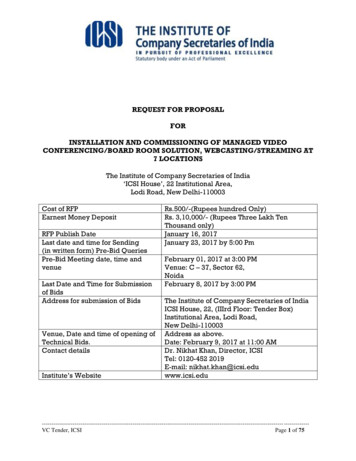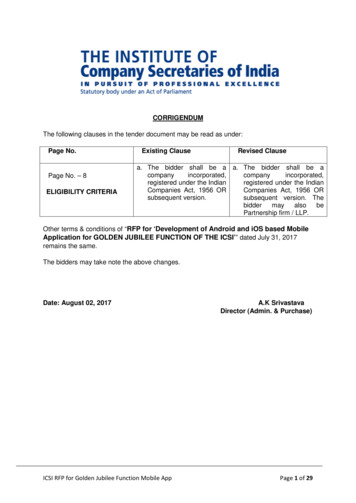
Transcription
GUIDELINE ANSWERSEXECUTIVE PROGRAMME(New Syllabus)DECEMBER 2019MODULE 1ICSI House, 22, Institutional Area, Lodi Road, New Delhi 110 003Phones : 41504444, 45341000; Fax : 011-24626727E-mail : info@icsi.edu; Website : www.icsi.edu
These answers have been written by competent personsand the Institute hope that the GUIDELINE ANSWERS willassist the students in preparing for the Institute'sexaminations. It is, however, to be noted that the answersare to be treated as model answers and not as exhaustiveand the Institute is not in any way responsible for thecorrectness or otherwise of the answers compiled andpublished herein.The Guideline Answers contain the information based on theLaws/Rules applicable at the time of preparation. However,students are expected to be well versed with the amendmentsin the Laws/Rules made upto six months prior to the date ofexamination.C O N T E N T SPageMODULE 11. Jurisprudence, Interpretation & General Laws.12. Company Law.193. Setting up of Business Entities and Closure.454. Tax Laws.66
1EP–JI&GL–December 2019EXECUTIVE PROGRAMME EXAMINATIONDECEMBER 2019JURISPRUDENCE, INTERPRETATION & GENERAL LAWSTime allowed : 3 hoursMaximum marks : 100NOTE : Answer ALL Questions.Question 1(a) Discuss the ‘‘Doctrine of Stare Decisis’’, under the sources of law.(b) Rajasthan Legislature passed a law restricting the use of sound amplifiers. Thelaw was challenged on the ground that it deals with a matter which falls in entry81 of List-I under the Constitution of India which reads :‘‘Post and telegraphs, telephones, wireless broadcasting and other like forms ofcommunication’’ and therefore, the State Legislature was not competent to passit. Examine the proposition in the light of ‘‘Pith and Substance Rule’’ referringthe case law on this point.(c) Describe ‘‘Arbitration Agreement’’ specified under Section 7 of the Arbitrationand Conciliation Act, 1996.(d) Describe the ‘‘Rule of Reasonable Construction’’ under the Interpretation ofStatutes.(5 marks each)Answer 1(a)The doctrine of stare decisis means adherence to the past decision and do notunsettle things which are established. It is a useful doctrine intended to bring aboutcertainty and uniformity in the law. Under the stare decisis doctrine, a principle of lawwhich has become settled by a series of decisions generally is binding on the courts andshould be followed in similar cases. In simple words, the principle means that like casesshould be decided alike. This doctrine is based on public policy. Although doctrineshould be strictly adhered to by the Courts, it is not universally applicable. The doctrineshould not be regarded as a rigid and inevitable doctrine which must be applied at thecost of justice.Answer 1(b)The Rule of Pith and Substance means that where a law in reality and substancefalls within an item on which the legislature which enacted that law is competent tolegislate, then such law shall not become invalid merely because it incidentally touchesa matter outside the competence of legislature.Acting on Entry 6 of List II of the Constitution of India which reads — Public Healthand Sanitation, Rajasthan Legislature passed a law restricting the use of soundamplifiers. The law was challenged on the Schedule VII, entry 31 of List I of theConstitution of India deals with "Post and telegraphs, telephones, wireless broadcastingand other like forms of communication, and, therefore, the State Legislature was not1
EP–JI&GL–December 20192competent to pass it. The Supreme Court rejected this argument on the ground that theobject of the law was to prohibit unnecessary noise affecting the health of public and notto make a law on broadcasting, etc. Therefore, the pith and substance of the law was –public health and not – broadcasting (G. Chawla v. State of Rajasthan, AIR 1959 SC544).Answer 1(c)According to Section 2(1) (b) of the Arbitration and Conciliation Act, 1996, arbitrationagreement means an agreement referred to in Section 7 of the Act. Under Section 7, theArbitration agreement has been defined to mean an agreement by the parties to submitto arbitration all or certain disputes which have arisen or which may arise between themin respect of a defined legal relationship, whether contractual or not.— An arbitration agreement may be in the form of an arbitration clause in a contractor in the form of a separate agreement.— An arbitration agreement shall be in writing.— An arbitration agreement is in writing if it is contained in— a document signed by the parties;— an exchange of letters, telex, telegrams or other means of telecommunicationincluding communication through electronic means which provide a recordof the agreement; or— an exchange of statements of claim and defence in which the existence ofthe agreement is alleged by one party and not denied by the other.— The reference in a contract to a document containing an arbitration clauseconstitutes an arbitration agreement if the contract is in writing and the referenceis such as to make that arbitration clause part of the contract.Answer 1(d)According to Rule of Reasonable Construction the words of a statute must beconstrued ut res magis valeat quam pereat, so as to give a sensible meaning to them.A provision of law cannot be so interpreted as to divorce it entirely from common sense;every word or expression used in an Act should receive a natural and fair meaning.It is the duty of a Court in constructing a statute to give effect to the intention of thelegislature. If, therefore, giving of literal meaning to a word used by the draftsmanparticularly in penal statute would defeat the object of the legislature, which is to suppressa mischief, the Court can depart from the dictionary meaning which will advance theremedy and suppress the mischief.It is only when the language of a statute, in its ordinary meaning and grammaticalconstruction, leads to a manifest contradiction of the apparent purpose of the enactment,or to some inconvenience or absurdity, hardship or injustice, presumably not intended,a construction may be put upon it which modifies the meaning of the words and even thestructure of the sentence (Tirath Singh v. Bachittar Singh, A.I.R. 1955 S.C. 830).Courts can depart from dictionary meaning of a word and give it a meaning which will
3EP–JI&GL–December 2019advance the remedy and suppress the mischief provided the Court does not haveto conjecture or surmise. A construction will be adopted in accordance with the policyand object of the statute (Kanwar Singh v. Delhi Administration, AIR 1965 S.C. 871).Attempt all parts of either Q. No. 2 or Q. No. 2AQuestion 2(a) Explain the role of ‘Preamble’ as internal aid in interpretation of statute. Thoughthe preamble cannot be used to defect the enacting clause of a statute, it hasbeen treated to be a key for the interpretation of the statute. Examine.(b) Enumerate any four categories of cases in which a police officer may arrest aperson without an order from magistrate and without a warrant under section 41of Cr.P.C., 1973.(c) Allegation against the accused was that he furnished a certificate to getemployment as ETT Teacher which was found to be bogus and forged in asmuch as school was not recognized for period given in the certificate. However,the certificate did not anywhere say that school was recognized. Whether theaccused is guilty of any offence ? Explain with the help of decided judicialprecedent.(d) Explain the rights of a party to appear before the National Company Law Tribunal.(4 marks each)OR (Alternate question to Q. No. 2)Question 2A(i) Briefly explain the ‘Purposive Rule of Interpretation’ under the General ClausesAct, 1987.(4 marks)(ii) Enumerate in short the exceptional circumstances of the application of naturaljustice under Administrative Law.(4 marks)(iii) Discuss the provisions relating to persons under legal disability under theLimitation Act, 1963.(4 marks)(iv) Describe kinds of offences under which capital punishment may be awarded byCourt under Indian Penal Code.(4 marks)Answer 2(a)The true place of a preamble in a statute was at one time, the subject of conflictingdecisions. In Mills v. Wilkins, (1794) 6 Mad. 62, Lord Hold said: “the preamble of astatute is not part thereof, but contains generally the motives or inducement thereof”. Onthe other hand, it was said that “the preamble is to be considered, for it is the key to openthe meaning of the makers of the Act, and the mischief it was intended to remedy”.The modern rule lies between these two extremes and is that where the enactingpart is explicit and unambiguous the preamble cannot be resorted to, control, qualify orrestrict it, but where the enacting part is ambiguous, the preamble can be referred toexplain and elucidate it [Raj Mal v. Harnam Singh, (1928) 9 Lah. 260].
EP–JI&GL–December 20194In Powell v. Kempton Park Race Course Co., (1899) AC 143, 157, Lord Halsburysaid: “Two propositions are quite clear — One that a preamble may afford useful light asto what a statute intends to reach and another that, if an enactment is itself clear andunambiguous, no preamble can qualify or cut down the enactment”. Allahabad HighCourt has held in Kashi Prasad v. State, AIR 1967 All. 173, that even though the preamblecannot be used to defeat the enacting clauses of a statute, it has been treated to be akey for the interpretation of the statute.Supreme Court in Kamalpura Kochunni v. State of Madras, AIR 1960 SC 1080, pointedout that the preamble may be legitimately consulted in case any ambiguity arises in theconstruction of an Act and it may be useful to fix the meaning of words used so as tokeep the effect of the statute within its real scope.Answer 2(b)Section 41 of Criminal Procedure Code, 1973 provides that any police officer maywithout an order from a Magistrate and without a warrant, arrest any person:(a) Who commits, in the presence of a police office, a cognizable offence(b) against whom a reasonable complaint has been made, or credible informationhas been received, or a reasonable suspicion exists that he has committed acognizable offence punishable with imprisonment for a term which may be lessthan seven years or which may extend to seven years whether with or withoutfine, if the following conditions are satisfied, namely :(i) the police has reason to believe on the basis of such complaint, information,or suspicion that such person has committed the said offence;(ii) the police officer is satisfied that such arrest is necessary (a) to prevent such person from committing any further offence; or(b) for proper investigation of the offence; or(c) to prevent such person from causing the evidence of the offence todisappear or tampering with such evidence in any manner; or(d) to prevent such person from making any inducement, threat or promiseto any person acquainted with the facts of the case so as to dissuadehim from disclosing such facts to the Court or to the police officer;or(e) as unless such person is arrested, his presence in the Court wheneverrequired cannot be ensured and the police officer shall record whilemaking such arrest, his reason in writing;(ba) against whom credible information has been received that he has committed acognisable offence punishable with imprisonment for a term which may extendto more than seven years whether with or without fine or with death sentenceand the police officer has reason to believe on the basis of that information thatsuch person has committed the said offence;(c) who has been proclaimed as an offender either under this Code or by order of theState Government; or
5EP–JI&GL–December 2019(d) in whose possession anything is found which may reasonably be suspected tobe stolen property and who may reasonably be suspected of having committedan offence with reference to such thing; or(e) who obstructs a police officer while in the execution of his duty, or who hasescaped, or attempts to escape, from lawful custody; or(f) who is reasonably suspected of being a deserter from any of the Armed Forcesof the Union; or(g) who has been concerned in, or against whom reasonable complaint has beenmade, or credible information has been received, or a reasonable suspicionexists, of his having been concerned in, any act committed at any place out ofIndia which if committed in India, would have been punishable as an offence, andfor which he is, under any law relating to extradition, or otherwise, liable to beapprehended or detained in custody in India; or(h) who, being a released convict, commits a breach of any rule, made under (section356(5); or(i) for whose arrest any requisition, whether written or oral, has been received fromanother police officer, provided that the requisition specifies the person to bearrested and the offence or other cause for which the arrest is to be made and itappears therefrom that the person might lawfully be arrested without a warrantby the officer who issued the requisition.Answer 2(c)The Supreme Court in the case of Ramchandran v. State, AIR 2010 SC 1922, hasheld that to constitute an offence of forgery document must be made with dishonest orfraudulent intention. A person is said to do a thing fraudulently if he does that thing withintent to defraud but not otherwise. The Supreme Court in the case of Parminder Kaur v.State of UP, has held that mere alteration of document does not make it aforged document. Alteration must be made for some gain or for some objective.Similarly, in the case of Balbir Kaur v. State of Punjab, 2011 CrLJ 1546 (P&H), theallegation against the accused was that she furnished a certificate to get employment asETT teacher which was found to be bogus and forged in as much as school was notrecognized for period given in certificate. However the certificate did not anywhere saythat school was recognized. It was held that merely indicating teaching experience ofthe accused, per-se, cannot be said to indicate wrong facts. So the direction which wasissued for prosecution is liable to be quashed.In view of the above, the accused is not guilty of any offence.Answer 2(d)Rights of a party to appear before the National Company Law Tribunal are as under:(1) Every party may appear before a Tribunal in person or through an authorisedrepresentative, duly authorised in writing in this behalf.(2) The authorised representative shall make an appearance through the filing of
EP–JI&GL–December 20196Vakalatnama or Memorandum of Appearance in specified Form representingthe respective parties to the proceedings.(3) The Central Government, the Regional Director or the Registrar of Companies orOfficial Liquidator may authorise an officer or an Advocate to represent in theproceedings before the Tribunal.(4) The officer authorised by the Central Government or the Regional Director or theRegistrar of Companies or the Official Liquidator shall be an officer not below therank of Junior Time Scale or company prosecutor.Answer 2A(i)In Halsbury‘s Laws of England, it is stated : “Parliament intends that an enactmentshall remedy a particular mischief and it is therefore presumed that Parliament intendsthat the court, when considering, in relation to the facts of the instant case, which of theopposing constructions of the enactment corresponds to its legal meaning, should find aconstruction which applies the remedy provided by it in such a way as to suppress thatmischief.”The doctrine originates in Heydon‘s case where the Barons of the Exchequer resolvedthat for the sure and true interpretation of all statutes in general (be they penal or beneficial,restrictive or enlarging of the common law), four things are to be discerned and considered: what was the common law before the making of the Act; what was the mischief and defect for which the common law did not provide; what remedy Parliament has resolved and appointed to cure the disease of thecommonwealth; and the true reason of the remedy and the office of all the judges is always to makesuch construction as shall ––suppress the mischief and advance the remedy; and – suppress subtleinventions and evasions for the continuance of the mischief pro privatecommode (for private benefit); and–add force and life to the cure and remedy according to the true intent of themakers of the Act pro bono publico (for the public good).Answer 2A(ii)Though the normal rule is that a person who is affected by administrative action isentitled to claim natural justice, that requirement may be excluded under certainexceptional circumstances as mentioned below:1. Statutory Exclusion : The principle of natural justice may be excluded by thestatutory provision. Where the statute expressly provides for the observance ofthe principles of natural justice, the provision is treated as mandatory and theauthority is bound by it. Where the statute is silent as to the observance of theprinciple of natural justice, such silence is taken to imply the observance thereto.2. Emergency : In exceptional cases of urgency or emergency where prompt and
7EP–JI&GL–December 2019preventive action is required the principles of natural justice need not be observed.However, the determination of the situation requiring the exclusion of the rules ofnatural justice by the administrative authorities is not final and the court mayreview such determination.3. Interim disciplinary action : The rules of natural justice are not attracted in thecase of interim disciplinary action.4. Academic evaluation : Where a student is removed from an educational institutionon the grounds of unsatisfactory academic performance, the requirement ofpre-decisional hearing is excluded.5. Impracticability : Where the authority deals with a large number of person it isnot practicable to give all of them opportunity of being heard and therefore insuch condition the court does not insist on the observance of the rules of naturaljustice.Answer 2A(iii)Section 6 of the Limitation Act, 1963 provides that where a person entitled to institutea suit or make an application for the execution of a decree is, at the time from which theprescribed period is to be reckoned, a minor or insane, or an idiot, he may institute thesuit or make the application within the same period after the disability has ceased, aswould otherwise have been allowed from the time specified there for in the Schedule ofthe Act.Where such person is, at the time from which the prescribed period is to be reckoned,affected by two such disabilities, or where, before his disability has ceased, he is affectedby another disability, he may institute the suit or make the application within the sameperiod after both disabilities have ceased, as would otherwise have been allowed fromthe time so specified.Where the disability continues up to the death of that person, his legal representativemay institute the suit or make the application within the same period after the death, aswould otherwise have been allowed from the time so specified.Where a person under disability dies after the disability ceases but within the periodallowed to him under this section, his legal representative may institute the suit or makethe application within the same period after the death, as would otherwise have beenavailable to that person had he not died.Section 6 of the Act is an enabling section to enable persons under disability toexercise their legal rights within a certain time. Section 7 which deals with disability ofone of several persons supplements Section 6, Section 8 deals with special exceptioncontrols sections 6 and 7 , which serves as an exception to Sections 6 and 7. Thecombined effect of Sections 6 and 8 is that where the prescribed period of limitationexpires before the cessation of disability, for instance, before the attainment of majority,the minor will no doubt be entitled to a fresh period of limitation from the attainment ofhis majority subject to the condition that in no case the period extended by Section 6shall by virtue of Section 8 exceeds three years from cessation of disability, i.e. attainmentof majority.
EP–JI&GL–December 20198Answer 2A(iv)A death sentence is the harshest of punishments provided in the Indian Penal Code(IPC), which involves the judicial killing or taking the life of the accused as a form ofpunishment. The Supreme Court has ruled that death sentence ought to be imposedonly in the "rarest of rare cases". The IPC provides for capital punishment for the followingoffences:(a) Murder(b) Dacoity with Murder.(c) Waging War against the Government of India.(d) Abetting mutiny actually committed.(e) Giving or fabricating false evidence upon which an innocent person suffers death(f) Abetment of a suicide by a minor or insane person;(g) Attempted murder by a life convict.The capital punishment is awarded only in two categories of offences, namely treasonand murder. In either of the cases, when the court decides that death penalty is theappropriate sentence to be imposed in the light of the gravity of matter and consequencesof the offence committed and the absence of mitigating factors, then the court under theprovisions of section 354(3) of Criminal Procedure Code (CrPC) has to give special reasonsas to why the court came to this conclusion.Question 3(a) What do you understand by ‘set off’ and ‘counter-claim’ under the Civil ProcedureCode, 1908 ? What is the effect of set-off ?(b) Describe in brief the cases in which a Search Warrant can be issued underSection 93 in the Criminal Procedure Code, 1973.(c) What is the extent of liability of instruments to stamp duty where severalinstruments are executed in a single transaction ? Explain with any one illustration.(d) Judicial review is the authority of Courts to declare void the acts of the legislatureand executive, if they are found in violation of provisions of the Constitution.Comment.(4 marks each)Answer 3(a)Set-offOrder VIII, Rule 6 of Civil Procedure Code, 1908 deals with set-off which is a reciprocalacquittal of debts between the plaintiff and defendant. It has the effect of extinguishingthe plaintiff's claim to the extent of the amount claimed by the defendant as a counterclaim.Under Order VIII , Rule 6 of Civil Procedure Code, 1908 where in a suit for therecovery of money the defendant claims to set off against the plaintiff?s demand anyascertained sum of money legally recoverable by him from the plaintiff not exceeding the
9EP–JI&GL–December 2019pecuniary jurisdiction of the Court and where both parties fill the same character as inthe plaintiff is suit, the defendant may, at the first hearing of the suit, but not afterwardsunless permitted by the Court, present a written statement containing the particulars ofthe debt sought to be set-off.Counter-claimA defendant in a suit may, in addition to his right of pleading a set-off under Rule 6,set up by way of counterclaim against the claim of the plaintiff, any right or claim inrespect of a cause of action accruing to the defendant against the plaintiff either before orafter the filling of the suit but before the defendant has delivered his defence or before thetime limited for delivering his defence has expired, whether such counterclaim is in thenature of claim for damages or not. Such counter-claim must be within the pecuniaryjurisdiction of the Court. (Order VIII, Rule 6A).Effect of Set-offThe written statement shall have the same effect as a plaint in a cross-suit so as toenable the Court to pronounce a final judgement in respect both of the original claim andof the set-off, but this shall not affect the lien, upon the amount decreed, of any pleaderin respect of the costs payable to him under the decree.Answer 3(b)According to Section 93 of the Criminal Procedure Code, 1973, a search warrant canbe issued only in the following cases:(i) Where the Court has reason to believe that a person summoned to produce anydocument or other thing, will not produce it(ii) Where such document or other thing is not known to the Court to be in thepossession of any person(iii) Where a general inspection or search is necessary. However, a search warrantmay be general or restricted in its scope as to any place or part thereof.Answer 3(c)Section 4 of Indian Stamp Act, 1899 provides that, where in the case of any sale,mortgage or settlement, several instruments are employed for completing the transaction–(i) Only the principal amount shall be chargeable with the duty prescribed for theconveyance, mortgage or settlement(ii) Each of the other instrument shall be chargeable with a duty of one rupee (insteadof the duty if any prescribed for the other instruments)Illustrations(i) A executed a conveyance of immovable property. On the same deed his nephew(undivided in status) endorsed his consent to the sale, as such consent wasconsidered to be necessary. It was held that the conveyance was the principalinstrument. The consent was chargeable with only one rupee (ILR 13 Bom 281).(ii) Subsequent to a sale of immovable property, two declarations were executed
EP–JI&GL–December 201910reciting that the sale was subject to an equitable mortgage created by the vendor.These declarations were held to be chargeable, together with the sale deed, ashaving completed the conveyance (Somaiya Organics Ltd. v. Chief ControllingRevenue Authority, AIR 1972 All 252).(iii) Brother A executed in favour of brother B a gift of all his property. By anotherdeed, brother B made provision for the living expenses of brotherA andhypothecating in favour of brother A a part of the property included in the abovementioned gift deed, in order to secure the payment of the living expenses. Itwas held that the two documents were part of the same transaction. Theyamounted to a settlement and Section 4 applied (Maharaj Someshar Dutt, ILR37 All 264).(iv) B conveyed the whole of his property to three persons who undertook to providefor him and to perform his obsequies. By another document, the three doneesagreed to provide for B. This was mentioned in the deed executed by A also. Itwas held that the two documents had to be construed as part of the same act;the first was liable to duty as a conveyance while the second was liable to a dutyof Rupee 1 only (Dadoba v. Krishna, ILR 7 Bom. 34).(v) A company executed, first a deed of trust and mortgage stating that the companywas to issue notes for raising loans secured by the sale deed. It was held asunder:(1) The deed was principal or primary security (and not a collateral security). Itwas chargeable as mortgage under Article 14.(2) The notes issued subsequently were debentures and not principal instruments(Madras Refinery Ltd. v. Chief Controlling Revenue Authority, Madras, AIR1977 SC 500).Answer 3(d)The biggest check over administrative action is the power of judicial review. Judicialreview is the authority of Courts to declare void the acts of the legislature and executive,if they are found in violation of provisions of the Constitution. Judicial Review is the powerof the highest Court of a jurisdiction to invalidate on Constitutional grounds, the acts ofother Government agency within that jurisdiction.The power of judicial review controls not only the legislative but also the executive oradministrative act. The Court scrutinizes the executive act for determining the issue asto whether it is within the scope of authority or power conferred on the authority exercisingthe power. Where the act of executive or administration is found ultra-virus the Constitutionor the relevant Act, it is declared as such and, therefore, void. The Courts attitude appearsto be stiffer in respect of discretionary powers of the executive or administrative authorities.The Court is not against the vesting of discretionary power in the executive, but it expectsthat there would be proper guidelines for the exercise of power. The Court interferes whenthe uncontrolled and unguided discretion is vested in the executive or administrativeauthorities or the repository of the power abuses its discretion.Question 4(a) Discuss briefly ‘‘Malicious Prosecution’’ and its essential elements under thelaw relating to Torts.
11EP–JI&GL–December 2019(b) Explain the special provisions as to Evidence relating to Electronic Record underthe provisions of the Indian Evidence Act, 1872.(c) State at least four instruments which are exempted from the provisions of Section17(1) of the Registration Act, 1908.(d) Explain any four categories of ‘information’ which have been exempted fromdisclosure under the Right to Information Act, 2005.(4 marks each)Answer 4(a)Malicious prosecution consists in instigating judicial proceedings (usuallycriminal) against another, maliciously and without reasonable and probable cause,which terminate in favour of that other and which results in damage to his reputation,personal freedom or property.The following are the essential elements of this tort:(i) There must have been a prosecution of the plaintiff by the defendant.(ii) There must have been want of reasonable and probable cause for that prosecution.(iii) The defendant must have acted maliciously (i.e. with an improper motive and notto further the end of justice).(iv) The plaintiff must have suffered damages as a result of the prosecution.(v) The prosecution must have terminated in favour of the plaintiff.Answer 4(b)Section 65A of the Indian Evidence Act, 1872 provides that the contents ofelectronic records may be proved in accordance with the provisions of Section 65B.As per Section 65B(1) of the Indian Evidence Act, 1872, any information containedin an electronic record which is printed on a paper, stored, recorded or copied in opticalor magnetic media produced by a computer (hereinafter referred to as thecomputer output) shall be deemed to be also a document, if the conditions mentioned inthis Section are satisfied in relation to the information and computer in question andshall be admissible in any proceedings, without further proof or production of the original,as evidence of any contents of the original or of any fact stated therein of wh
GUIDELINE ANSWERS EXECUTIVE PROGRAMME (New Syllabus) DECEMBER 2019 MODULE 1 ICSI House, 22, Institutional Area, Lodi Road, New Delhi 110 003 Phones: 41504444, 45341000; Fax: 011-24626727 E-mail: info@icsi.edu; Website: www.icsi.edu. These answers have been written by competent persons
